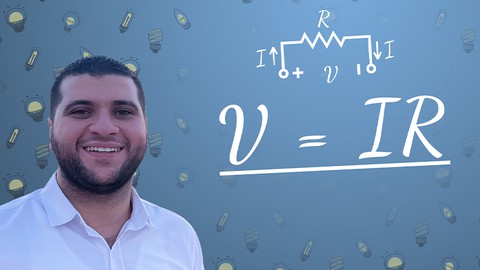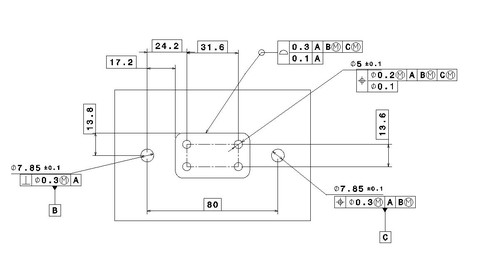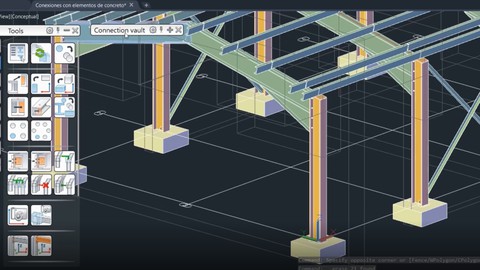The Ultimate Electric Circuits for Electrical Engineering
Loại khoá học: Industry
Learn DC electric circuits, Electronics, AC Circuits, AC power, Three phase circuits, and Resonance in ONE COURSE !
Mô tả
Hi everyone!
This course is designed to provide a complete understanding of electric circuits starting from the basics and fundamentals of electrical engineering moving to advanced topics in electric circuits for complete beginners without any previous knowledge.
Electric circuits analysis is the fundamental theory upon which all branches of electrical engineering are built. Many branches of electrical engineering, such as power engineering, electric machines, control, electronics, communications, and instrumentation, are based on electric circuit theory.
The course is roughly divided into the following topics:
<<<< Basics and fundamentals of electrical engineering and electronics >>>>
What is an electric circuit?
System of Units & SI Prefixes
Definitions of electric charge, current, voltage, power and energy
Basic circuit elements and their applications
DC current vs. AC current
Difference between independent and dependent sources
Power balance in electric circuits
<<<< Fundamental laws in DC electric circuits >>>>
Ohm's law in electric circuits
Various properties of resistors
Kirchhoff’s current law (KCL) and Kirchhoff’s voltage law (KVL)
Short circuit and open circuit
Circuit reduction topology using series and parallel resistors
Voltage and current divider rules
Star and delta connections
Star to Delta transformation and vice versa for the circuit reduction
Nodal analysis method and concept of super node
Electric circuit applications as lighting systems
<<<< Advanced theorems in DC circuit analysis >>>>
The concept of linearity and linear circuits
Different electric circuit theorems such as superposition and source transformation theorems
Thevenin theorem in electric circuits
How to apply Thevenin with dependent sources?
The maximum power transfer theory using Thevenin
Norton theorem in electric circuits
<<<< Capacitors and Inductors in Electric circuits >>>>
Various properties for capacitors and inductors
The voltage and current relations in capacitors and inductors
The energy stored in capacitors and inductors
How to simplify capacitive, and inductive circuits?
Series and parallel capacitors and inductors
<<<< Operational Amplifiers >>>>
Basics of operational amplifiers (Op-Amps)
Difference between ideal and practical Op-Amps
Different types of Op-Amps such as inverting, non inverting, summing and difference amplifiers
Different applications on Op-Amps such as differentiator, integrator, cascaded Op-Amps
How to implement digital to analog converter (DAC) using Op-Amps?
How to build instrumentation amplifier (IA) using Op-Amp circuits?
<<<< DC transient circuits >>>>
First order DC transient circuits
Forced and free response of R-L circuit
Forced and free response of R-C circuit
The key to working with any R-L or R-C circuits
The analysis of second order DC transient circuits
Analysis of series RLC circuit
Different responses for RLC circuit
How to analyze any general RLC circuit?
<<<< AC Electric Circuit Analysis >>>>
Practical difference between AC and DC circuits
AC sinusoidal sources and phasors
Identify the phasor representation for AC sources
V-I relations for resistors, inductors and capacitors in AC circuits
Definitions of impedance and admittance
Apply different circuit techniques and theorems in AC circuits
Apply KVL, KCL, impedance combinations, mesh and nodal techniques in AC circuits
Apply superposition, source transformation, Thevenin and Norton theorems in AC circuits
Realize Cramer's rule and the elimination technique in analyzing any AC electric circuit
Analysis of Op Amp AC circuits
<<<< Power in AC Circuits >>>>
Practical importance of AC power analysis
Difference between instantaneous and average power
Apply maximum power transfer theory in AC circuits
The root-mean-square (RMS) value and its importance in AC circuits
Identify the apparent power (S) and power factor (PF)
Discuss the complex power and its importance in AC power analysis
Difference between active power (P) and reactive power (Q)
Realize the power triangle in relating the different types of AC power
Realize the consequences of low power factor in AC power system
The role of capacitors in improving the power factor
<<<< Three Phase Circuits >>>>
The advantages of using 3-ph systems
The origin of balanced three phase supply
Study different possible connections in balanced 3-ph circuits
Apply (star-star), (star-delta), (delta-star), (delta-delta) 3-ph connections
Discuss the difference between (3-wire) and (4-wire) 3-ph systems
The difference between line and phase voltages
The relations between line and phase currents
How to analyze unbalanced star or delta loads in any 3-ph system
<<<< Power in Three Phase Circuits >>>>
Power calculations in balanced 3-ph system
Power calculations in unbalanced 3-ph system
How to calculate the power losses in any 3-ph system?
How to improve the power factor in 3-ph circuits?
<<<< Resonance in Electric Circuits >>>>
Realize the electric resonance phenomena in electric circuits
Series resonance vs. parallel resonance
Properties of resonant circuits
Half power frequencies in resonant circuits
Bandwidth and quality factor for electric resonance
Applications of resonance circuits
Drawbacks of unwanted resonance
You will find several solved examples and practical applications to illustrate the analysis of practical circuits
By the end of this course, you will be able to start your career in electrical engineering, power and
computer engineering and electronics so that you will be able to analyze different electric circuits
from basics to advanced
I thank you very much for taking the time to check the course content.
See you in the course !
Bạn sẽ học được gì
Electrical engineering and electronics fundamentals
Learn basics of simple electric circuit
Identify electric charge, current, voltage, power and energy
Identify the basic circuit elements and their applications
Realize the difference between independent and dependent sources
Discuss the various properties of resistors
Apply Ohm's law in electric circuits
Explain Kirchhoff’s current and voltage laws used in circuit analysis
Learn how to apply circuit reduction topology using series and parallel resistors
Explain the concept of Star and Delta transformations in reducing the electric circuits
Apply the rules of current and voltage divider in electric circuits
Discuss electric circuit applications as lighting systems
Learn electric circuit analysis techniques using Mesh and Nodal analysis
Realize the concept of super mesh and super node in electric circuits
Identify the concept of linear circuits
Learn different electric circuit theorems such as superposition and source transformation theorems
Learn how to apply Thevenin theorem in electric circuits
Discuss the maximum power transfer theory using Thevenin
Learn how to apply Norton theorem in electric circuits
Discuss the various properties for capacitors and inductors
Obtain the voltage and current relations in capacitors and inductors
Identify the energy stored in capacitors and inductors
Learn how to simplify capacitive, and inductive circuits
Learn the difference between resistor, capacitor and inductor
Identify basics of operational amplifiers (Op-Amps)
Discuss the difference between ideal and practical Op-Amps
Discuss different types of Op-Amps such as inverting, non inverting, summing and difference amplifiers
Realize different applications on Op-Amps such as differentiator, integrator, cascaded Op-Amps
Learn how to implement digital to analog converter (DAC) using Op-Amps
How to build instrumentation amplifier (IA) using Op-Amp circuits
Explain the first order DC transient circuits
Apply forced and free response to R-L circuit
Apply forced and free response to R-C circuit
Realize the key to working with any R-L or R-C circuits
Explain the analysis of second order DC transient circuits
analyze series RLC circuit
Identify the different responses for RLC circuit
Learn how to analyze any general RLC circuit
Complete analysis of AC electric circuits
Realize the practical difference between AC and DC circuits
Discuss AC sinusoidal sources
Identify the phasor representation for AC sources
Identify the phasor representation for resistors, inductors and capacitors in AC circuits
Realize the definitions of impedance and admittance
Apply different circuit techniques and theorems in AC circuits
Apply KVL, KCL, impedance combinations, mesh and nodal techniques in AC circuits
Apply superposition, source transformation, Thevenin and Norton theorems in AC circuits
Realize Cramer's rule and the elimination technique in analyzing any AC electric circuit
Learn how to analyze Op Amp AC circuits
Complete AC power analysis
Explain the practical importance of AC power analysis
Explain the Difference between instantaneous and average power
Apply maximum power transfer theory in AC circuits
Realize the root-mean-square (RMS) value and its importance in AC circuits
Identify the apparent power (S) and power factor (PF)
Discuss the complex power and its importance in AC power analysis
Discuss the difference between active power (P) and reactive power (Q)
Realize the power triangle in relating the different types of AC power
Realize the consequences of low power factor in AC power system
Learn the role of capacitors in improving the power factor
Complete analysis of three-phase circuits
Explain the advantages of using 3-ph systems
Learn the origin of balanced three phase supply
Study different possible connections in balanced 3-ph circuits
Apply (star-star), (star-delta), (delta-star), (delta-delta) 3-ph connections
Discuss the difference between (3-wire) and (4-wire) 3-ph systems
Identify the difference between line and phase voltages
Identify the relations between line and phase currents
Complete study on Unbalanced 3-phase systems
Learn how to analyze unbalanced star or delta loads in any 3-ph system
Discuss the power analysis in balanced 3-ph system
Explain the power analysis in unbalanced 3-ph system
How to improve the power factor in 3-ph circuits
Realize the electric resonance in electric circuits
Series resonance vs. parallel resonance
Explain different terms related to electric resonance
Identify applications of resonance circuits
Realize the drawbacks of unwanted resonance
Yêu cầu
- No prior knowledge about electrical engineering
- Basic knowledge of mathematics
- calculator
Nội dung khoá học
Viết Bình Luận
Khoá học liên quan

Đăng ký get khoá học Udemy - Unica - Gitiho giá chỉ 50k!
Get khoá học giá rẻ ngay trước khi bị fix.


















Đánh giá của học viên
Bình luận khách hàng